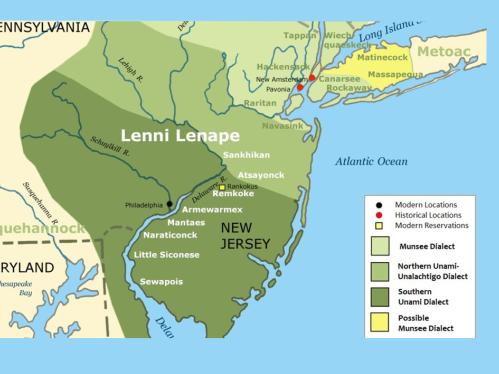
Recognize Native Land
Why Introduce the Practice of Land Acknowledgment?
A land acknowledgment is a simple, powerful way of showing respect and a step toward correcting the stories and practices that erase Indigenous people’s history and culture, and toward inviting and honoring the truth.
Accordion Content
-
We acknowledge that the land on which we stand is the ancestral territory of the Lenape People. We pay respect to Indigenous people throughout the Lenape diaspora – past, present, and future – and honor those who have been historically and systemically disenfranchised. We also acknowledge that Rutgers University, like New Jersey and the United States as a nation, was founded upon the exclusions and erasures of Indigenous peoples.
-
A statement is usually read at the beginning of an event by the host and expresses an institution’s commitment to histories, present realities, and future possibilities between Indigenous People, the institution, and the land. As you aim to incorporate land acknowledgments into events, meetings, and bibliographies, consult the resources below to learn more:
United States Department of Arts & Culture Honor Native Land: A Guide & Call To Acknowledgement
Know the Land Territories Campaign
Princeton University Land Acknowledgements General Guidelines
Northwestern University Native American and Indigenous Initiatives
Recognition and Respect
Rutgers University sits on the traditional territory of the Lenni-Lenape, called "Lenapehoking." Though we do not have a policy requiring land acknowledgments, this page is designed to provide resources for offices and event planners who wish to use this practice in a respectful, thoughtful manner.
To recognize the land is an expression of gratitude and appreciation to those whose territory you reside on and a way of honoring the Indigenous people who have been living and working on the land from time immemorial.

Native Americans in Rutgers History
The Scarlet and Black Project was a historical exploration of the experiences of two disenfranchised populations, African Americans and Native Americans, at Rutgers University. Scarlet and Black, Volume 1: Slavery and Dispossession in Rutgers History, traced the university’s early history, uncovering how the university benefited from the slave economy and how Rutgers came to own the land it inhabits.
Chapter 1 tells the story of the Lenni Lenape Indians who were mostly displaced from New Jersey decades before the university’s founding, as well as those few who still lived in Central Jersey at the time the school was created, and whose young people were sent to an Indian boarding school in Connecticut rather than being welcomed at Queen’s College. Scarlet and Black also explores how the university benefited from the Morrill Act of 1862—the federal program that funded schools for the study of agriculture and the mechanical arts through the sale of Indian land out west.

Moving Beyond Acknowledgment
Consider a few of the following resources for continued learning and engagement:
- Meaning of the Seed Documentary
- All My Relations Podcast
- Native American Heritage Month
- Rutgers Native American Cultural Association
- #HonorNativeLand Virtual Resource Pack
- Take the #HonorNativeLand Pledge
- Download #HonorNativeLand Art
- ‘We just want to be welcomed back’: The Lenape seek a return home
